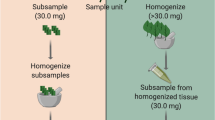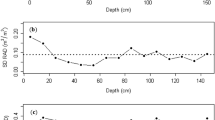Abstract
Bacterial populations on above-ground plant surfaces were estimated at three different biological scales, including leaflet disks, entire leaflets, and whole plants. The influence of sample scale on the estimation of mean bacterial population size per unit and per gram and on the variability among sampling units was quantified at each scale. Populations were highly variable among sampling units at every scale examined, suggesting that there is no optimal scale at which sample variance is reduced. The distribution of population sizes among sample units was sometimes, but not consistently, described by the lognormal. Regardless of the sampling scale, expression of population sizes on a per gram basis may not reduce variance, because population size was not generally a function of sample unit weight within any single sampling scale. In addition, the data show that scaling populations on a per gram basis does not provide a useful means of comparing population estimates from samples taken at different scales. The implications of these results for designing sampling strategies to address specific issues in microbial ecology are discussed.
Similar content being viewed by others
References
Andrews JH, Kenerley CM, Nordheim EV (1980) Positional variation in phylloplane microbial populations within an apple tree canopy. Microb Ecol 6:71–84
Campbell CL, Madden LV (1990) Introduction to plant disease epidemiology. John Wiley & Sons, New York
de Cleene M (1989) Scanning electron microscopy of the establishment of compatible and incompatible Xanthomonas campestris pathovars on the leaf surface of Italian ryegrass and maize. EPPO Bull 19:81–88
Donegan K, Matyac C, Seidler R, Porteous A (1991) Evaluation of methods for sampling, recovery, and enumeration of bacteria applied to the phylloplane. Appl Environ Microbiol 57:51–56
Gibbons JD (1985) Nonparametric methods for quantitative analysis, 2nd Ed. American Sciences Press, Columbus, Ohio
Hirano SS, Baker LS, Upper CD (1985) Ice nucleation temperature of individual leaves in relation to population sizes of ice nucleation active bacteria and frost injury. Plant Physiol 77:259–265
Hirano SS, Nordheim EV, Amy DC, Upper CD (1982) Lognormal distribution of epiphytic bacterial populations on leaf surfaces. Appl Environ Microbiol 44:695–700
Hirano SS, Rouse DI, Upper CD (1987) Bacterial ice nucleation as a predictor of bacterial brown spot disease on snap beans. Phytopathology 77:1078–1084
Hirano SS, Upper CD (1986) Temporal, spatial, and genetic variability of leaf-associated bacterial populations. In: Fokkema NJ and Van den Heuvel J (ed) Microbiology of the phyllosphere. Cambridge University Press, Cambridge, England, pp 235–251
Hirano SS, Upper CD (1990) Population biology and epidemiology of Pseudomonas syringae. Annu Rev Phytopathol 28:155–177
Ishimaru C, Eskridge KM, Vidaver AK (1991) Distribution analyses of naturally occurring epiphytic populations of Xanthomonas campestris pv. phaseoli on dry beans. Phytopathology 81:262–268
Kinkel LL (1992) Statistical consequences of combining population samples. Phytopathology 82:1168
Kinkel LL, Lindow SE (1990) Spatial distributions of Pseudomonas syringae strains on potato leaves. Phytopathology 80:1030
Kinkel LL, Wilson M, Lindow SE. 1990. Sampling phylloplane populations: distributional effects on sample design. Phytopathology 80:1030
Kloepper JW, Mahaffee WF, McInroy JA, Backman PA (1991). Comparative analysis of five methods for recovering rhizobacteria from cotton roots. Can J Microbiol 37:953–957
Leben C (1965) Influence of humidity on the migration of bacteria on cucumber seedlings. Can J Microbiol 11:671–675
Leben C (1969) Colonization of soybean buds by bacteria: observations with the scanning electron microscope. Can J Microbiol 15:319–320
Leben C, Schroth MN, Hildebrand DC (1970) Colonization and movement of Pseudomonas syringae on healthy bean seedlings. Phytopathology 60:677–680
Lindemann J, Arny DC, Upper CD (1984) Use of an apparent infection threshold population of Pseudomonas syringae to predict incidence and severity of brown spot of bean. Phytopathology 74:1334–1339
Lindemann J, Suslow TV (1987) Competition between ice nucleation-active wild-type and ice-nucleation-deficient deletion mutant strains of Pseudomonas syringae and Pseudomonas fluorescens Biovar I and biological control of frost injury on strawberry blossoms. Phytopathology 77:882–886
Lindow SE (1983) The role of bacterial ice nucleation in frost injury to plants. Annu Rev Phytopathol 21:363–384
Lindow SE (1985) Ecology of Pseudomonas syringae relevant to the field use of Ice− deletion mutants constructed in vitro for plant frost control. In: Halvorson HO, Pramer D, Rogul M (ed) Engineered organisms in the environment: Scientific Issues. Published by American Society for Microbiology, Washington, DC, pp 23–35
Lindow SE (1986) Strategies and practice of biological control of ice nucleation active bacteria on plants. In: Fokkema NJ, Van den Heuvel J (ed) Microbiology of the phyllosphere. Cambridge University Press, Cambridge, England, pp. 293–311
Lindow SE (1987) Competitive exclusion of epiphytic bacteria by Ice− mutants of Pseudomonas syringae. Appl Environ Microbiol 53:2520–2527
Lindow SE, Amy DC, Barchet WR, Upper CD (1978) The role of bacterial ice nuclei in frost injury to sensitive plants. In: Li P (ed) Plant cold hardiness and freezing stress. Academic Press, New York, pp 249–263
Lindow SE, Knudsen GR, Seidler RJ, Walter MV, Lambou VW, Amy PS, Schmedding D, Prince V, Hern S (1988) Aerial dispersal and epiphytic survival of Pseudomonas syringae during a pre-test for the release of genetically engineered strains into the environment. Appl Environ Microbiol 54:1557–1563
Loper JE, Lindow SE (1987) Lack of evidence for in situ fluorescent siderophore production by Pseudomonas syringae pv. syringae on bean leaf surfaces. Phytopathology 77:1449–1454
Luisetti J, Gaignard JL (1984) Variations in the distribution of Pseudomonas persicae epiphytic populations. In: Second International Working Group on Pseudomonas syringae pathovars. The Hellenic Phytopathological Society, Athens, Greece, pp 17–18
Mansvelt EL, Hattingh MJ (1987) Scanning electron microscopy of colonization pear leaves by Pseudomonas syringae pv. syringae. Can J Bot 65:2517–2522
Morris CE, Rouse DI (1986) Microbiological and sampling considerations for quantification of epiphytic microbial community structure. In: Fokkema NJ, Van den Heuvel J (ed) Microbiology of the phyllosphere, Cambridge University Press, Cambridge, England, pp 3–13
Rouse DI, Nordheim EV, Hirano SS, Upper CD (1985) A model relating the probability of foliar disease incidence to the population frequencies of bacterial plant pathogens. Phytopathology 75:505–509
Shapiro SS, Wilk MB (1965) An analysis of variance test for normality (complete samples). Biometrika 52:591–611
Sokal RR, Rohlf FJ (1981) Biometry. The principles and practice of statistics in biological research. WH Freeman, New York
Surico G (1993) Scanning electron microscopy of olive and oleander leaves colonized by Pseudomonas syringae subsp. savastanoi. J Phytopathol 138:31–40
Surico G, Kennedy BW, Ercolani GL (1981) Multiplication of Pseudomonas syringae pv. glycinea on soybean primary leaves exposed to aerosolized inoculum. Phytopathology 71:532–536
Author information
Authors and Affiliations
Additional information
Correspondence to: L.L. Kinkel
Rights and permissions
About this article
Cite this article
Kinkel, L.L., Wilson, M. & Lindow, S.E. Effect of sampling scale on the assessment of epiphytic bacterial populations. Microb Ecol 29, 283–297 (1995). https://doi.org/10.1007/BF00164891
Revised:
Issue Date:
DOI: https://doi.org/10.1007/BF00164891




